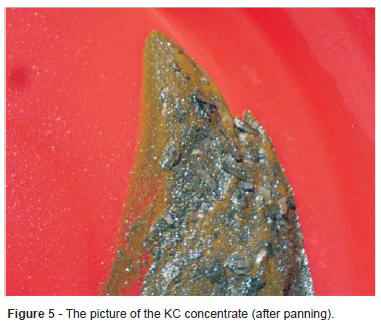The object of gravity concentration is the separation of the heavy valuable mineral from the light worthless gangue. Complications are often introduced by the fact that various base minerals must be separated from one another, an ore being subdivided into several products. Most gold ores, however, only require separation into two parts—the “concentrates,” in which the precious metal is contained, and the “ tailings,” which are thrown away. The German system of coarse crushing, sizing by means of screens, and concentrating on jigs, is not, as a rule, applicable to gold ores proper, although much used on auriferous lead, zinc, and copper ores. This system will not be described here, where only the methods in use for the treatment of battery sands, after passing over the amalgamated plates, will be considered.
All the concentrating machines depend for their action on the effect of a difference of densities on the fall of bodies in a fluid. The fluid employed in almost every instance is water, although several machines have been devised in which air is used as the concentrating medium. It has often been proposed to use some solution which shall have a lower density than the valuable mineral to be saved, but a higher density than the worthless gangue; the mineral would then sink, while the gangue would remain floating. The high cost of any such solution is sufficient to put this method out of the question, without discussing any further disadvantages.
The fall in water of solid materials takes place according to two laws, one applicable to very shallow water, through which the particles fall with increasing velocity, while the other is true when the depth of the water is considerable, so that the particles for the greater part of their course proceed at their maximum velocity. In shallow water the fall is almost entirely according to density, so that those machines which utilise only the first instants of the fall will have great efficacy in concentrating. It is this fact which has necessitated the use of shallow currents in concentrating tables, sluices, &c. In almost all these machines the fine sand and slime is brought into suspension in water, and the liquid is then run over an inclined surface. The deposit of sand, which is thus formed on the table, tends to become enriched in heavy minerals, because the stream moves faster at the surface of the water, where the lighter particles remain, than it does next the bed, where the heavy particles have settled. The deposit is continually worked up and brought again into suspension by a rake or broom, or by a series of shakes or blows imparted to the apparatus, so that the effect mentioned above is repeated frequently. If the stirring up is violently performed all the slime and very fine particles are kept in suspension in the water and carried away and lost, a slow stream of water and very slight agitation being favourable to their retention in the deposit which is formed. When the stream of water is rapid and voluminous, fine material, whether heavy or light, is swept away and lost in the tailings, whilst if too small a stream of water is used, much worthless sand is deposited with the concentrates. It follows that the amount of water used must be regulated according to the work which it is proposed to do. Frequently, it happens that clear water must be added to the pulp to dilute it sufficiently. On the other hand, it occasionally happens that the pulp is too thin, especially after hydraulic sizing, and water is then removed by means of settling boxes, described below.
Another operation, which it is often of the utmost importance to perform before concentration, is that of classification by size. The necessity of this is obvious, when it is remembered that a shallow stream of water swift enough to carry down fine sulphides, might be powerless to move a pebble of quartz. The usual method of classification is based on the varying rates of fall of particles through a deep column of water. In this way equal-falling particles are obtained together, and since a sphere of galena is equal-falling with a sphere of quartz of from 1.5 to nearly 4 times the diameter, according to the absolute sizes, it follows that the sizing cannot be perfectly performed by this method. Nevertheless, such sizing as is possible in this way, when efficiently performed, is of great assistance as a preparation for treatment by shallow-stream concentrators. Sizing by screens is more perfect, and may come into more extended use.
